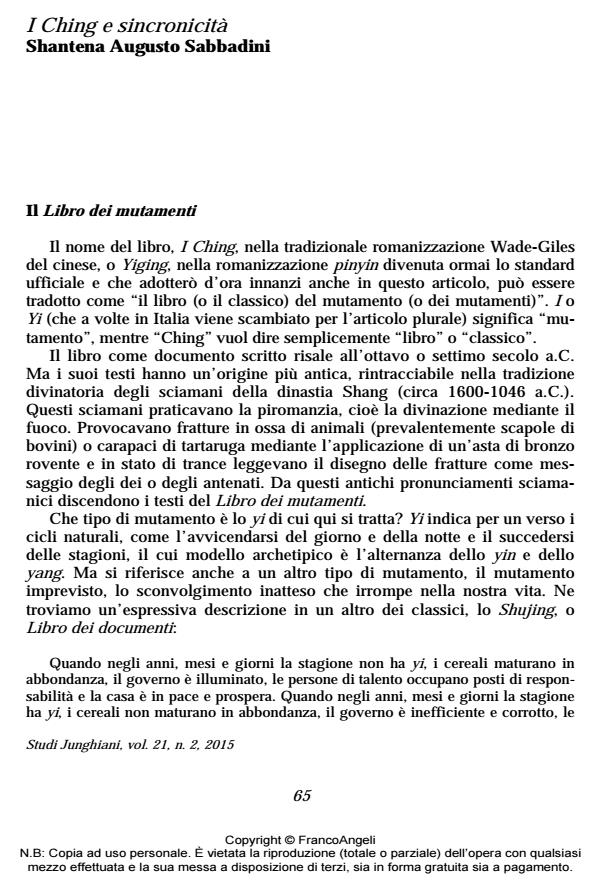I Ching and synchronicity
Journal title STUDI JUNGHIANI
Author/s Shantena Augusto Sabbadini
Publishing Year 2016 Issue 2015/42 Language Italian
Pages 19 P. 65-83 File size 96 KB
DOI 10.3280/JUN2015-042005
DOI is like a bar code for intellectual property: to have more infomation
click here
Below, you can see the article first page
If you want to buy this article in PDF format, you can do it, following the instructions to buy download credits

FrancoAngeli is member of Publishers International Linking Association, Inc (PILA), a not-for-profit association which run the CrossRef service enabling links to and from online scholarly content.
The I Ching or Yijing is an ancient Chinese oracular book whose texts have their origin in shamanic divination practices of the Shang dynasty (ca. 1600-1046 B.C.). These texts are organized in terms of sixty-four hexagrams, graphs consisting of six whole or broken lines, corresponding respectively to yang and yin. Therefore the book is a bridge between two different perspectives on reality, the intuitive and imaginal approach of shamanic trance and the structured and rational approach of yin-yang philosophy. For the ancient Chinese the Yijing was a map of "heaven and earth", i.e. of the totality of existence. As in many other forms of divination, the consultation relies on a random procedure, which points to a very different mental attitude towards what we call "chance". Jung has called this attitude "synchronicity", a topic examined in depth in his correspondence with Wolfgang Pauli. After a brief discussion of the concept of synchronicity based on the above correspondence, the article traces the history of the Yijing from its origins to its present diffusion in the West, paying special attention to the studies realized at Eranos, in which the author has been personally involved
Keywords: I Ching, Yijing, divinazione, sincronicità, Jung, Pauli, Eranos
- Gaudissart I., Gaudissart P. (2003). Le Yi Jing Eranos. Paris: Encre. Sous la direction de R. Ritsema.
- Jung C.G. (1971). Mysterium Coniunctionis (trad. it. Mysterium Coniunctionis. In: Opere, vol. 14, 1 e 2. Torino: Boringhieri, 1989).
- Karlgren B. (1950). The Book of Documents. The Bulletin of the Museum of Far Eastern Antiquities, Stockholm.
- Pauli W., Jung C.G. (1992). Wolfgang Pauli und C.G. Jung. Ein Briefwechsel, 1932-1958. Berlin, Heidelberg: Springer-Verlag (trad. it. Spirito e materia, Wolfgang Pauli e C.G. Jung. Corrispondenza 1932-1958, a cura di A. Sparzani. Milano: Moretti & Vitali, 2015).
- Ritsema R., Karcher S. (1994). I Ching, The Classic Chinese Oracle of Change. Shaftesbury: Element Books.
- Ritsema R., Sabbadini A.S. (1996). Eranos I Ching. Il libro della versatilità. Como: Red Edizioni.
- Ritsema R., Sabbadini A.S. (2005). The Original I Ching Oracle. London: Watkins.
- Ritsema R., Schneider H. (2000). Eranos Yi Jing. Das Buch der Wandlungen. München: Barth.
- Sabbadini A.S., Ritsema R. (2010). I Ching. Il libro dei mutamenti. Milano: URRA/Fel tri nel li.
- Vandermeersch L. (1988). Origine de la divination par l’achillée et forme primitive du Yi Jing. Hexagrammes, 4: 22.
- Wilhelm R., a cura di (1991). I Ching. Il Libro dei Mutamenti, prefazione di C.G. Jung. Milano: Adelphi Edizioni.
Shantena Augusto Sabbadini, I Ching e sincronicità in "STUDI JUNGHIANI" 42/2015, pp 65-83, DOI: 10.3280/JUN2015-042005